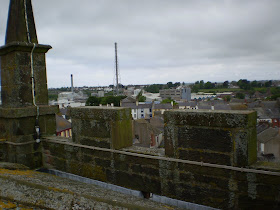 I've never seen ice in the sea before. We went to Silloth yesterday, and, well, I have now. It is hard for the sea to freeze for 2 reasons:
I've never seen ice in the sea before. We went to Silloth yesterday, and, well, I have now. It is hard for the sea to freeze for 2 reasons:1. Salt water needs to go down to -6 degrees C to freeze.
2. The sea has such a large thermal mass that it is hard for its temperature to change much. The work about specific heat capacity and latent heat is now at the end of the Upper Sixth but it is not difficult. It means that oceans always stay at roughly the same temperature, which is why coastal climates don't suffer from extremes.
This ice must have formed on the rivers up stream and be flowing out to sea, rather than being frozen brine. Famously, the same phenomenon took out the original Bowness railway viadeuct in the 1880s.

















































